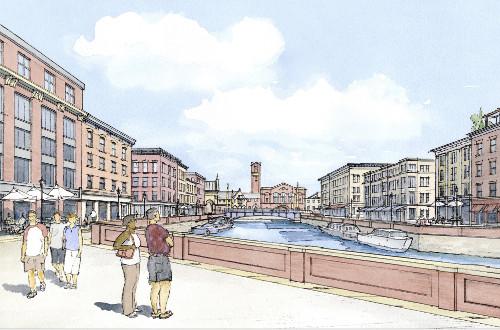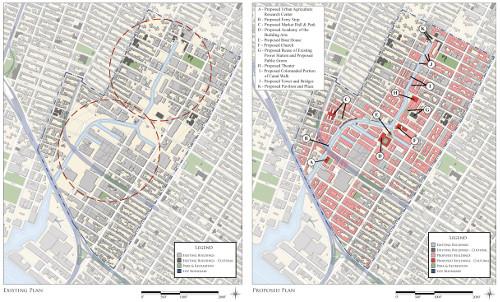
From Cleanup to Community: Envisioning a Flourishing Gowanus Neighborhood
Location: New York, NY. Neighborhood, District, and Corridor
SITE: 405 acre Superfund redevelopment in the Gowanus neighborhood of southwest Brooklyn, NY
Program: Proposed vision of a healthy future for the Gowanus Canal and community
Situated in southwest Brooklyn, Gowanus is bordered by three vibrant neighborhoods – Boerum Hill, Carroll Gardens and Park Slope – and the elevated Gowanus Expressway. The neighborhood covers an area approximately one mile by one-half mile, and is bisected by the Gowanus Canal.
Once a freight transportation hub, the Gowanus Canal was named an EPA federal Superfund site in March 2010. The combination of unmanaged industrial runoff, raw sewage and a malfunctioning pump station – combined with the departure of most of the industry that brought life to this neighborhood – left Gowanus desolate and forgotten. The formerly dynamic, mixed-use community now contains some light-to-medium industry and a few artists’ workshops and lofts. Despite years of neglect, current cleanup work and interest from private developers suggest great potential.
The Gowanus Neighborhood Proposal, submitted by University of Notre Dame Students Jennifer Griffin and John Griffin, is the product of an academic exercise that transforms a once derelict area into a healthy and vibrant community. Described as the “most beautiful project submitted out of all the projects reviewed” by juror Mike Lydon, the Gowanus Neighborhood Proposal illustrates a series of strategies and guidelines for future development that consider health, ecology, connectivity, safety, diversity, and preservation. In addressing the concerns of the neighborhood and community, Griffin and Griffin suggest creative solutions to common issues, including the use of warehouse roofs for urban farms and community gardens; ferry routes for the transportation of goods and people; and adaptive reuse of historic and culturally significant buildings, such as transforming the former MTA Power Station into a community center and YMCA.
In addition to the challenge of cleaning up the Superfund site, the Gowanus Neighborhood is currently designated as single-use zoning. To achieve the proposed mixed-use walkable neighborhood, the Proposal includes a study of how adaptive industrial buildings types, such as those in the neighborhood, can be successfully integrated into a mixed-use neighborhood over time. Griffin and Griffin demonstrate sensitivity to the policies and fabric of the surrounding community, and develop “at a scale that’s appropriate to the area,” says Mike Lydon. Visual depictions of the revitalized area show a cohesive and complete community that could have existed for the last 100 years.
As described in the project submission, the Proposal seeks to offer a “comprehensive vision, not a rigid solution” for overcoming the challenges and capitalizing on the existing assets of Gowanus. The illustration of strategies and guidelines for future development paint an attractive picture of a community that could be described as a “new urbanist dream”.
Transect Zone(s): T4 general, T5 center.
Status: Proposed
Project or Plan's Scale: Neighborhood
Features: Live/work, Mixed uses, Waterfront.
Land area (in acres): 405
Total built area (in sq. ft.):
Total project cost (in local currency):
Retail area (in sq. ft.):
Office area (in sq. ft.):
Industrial area (in sq. ft.):
Number of hotel units:
Number of residential units (include live/work):
Parks & green space (in acres):
Residential types: Mid-rise/loft.
Project team designers: Jennifer Griffin and John Griffin
Project team developers: N/A
Previous site status: Brownfield (former industrial)
Starting/Ending date of construction/implementation: -




